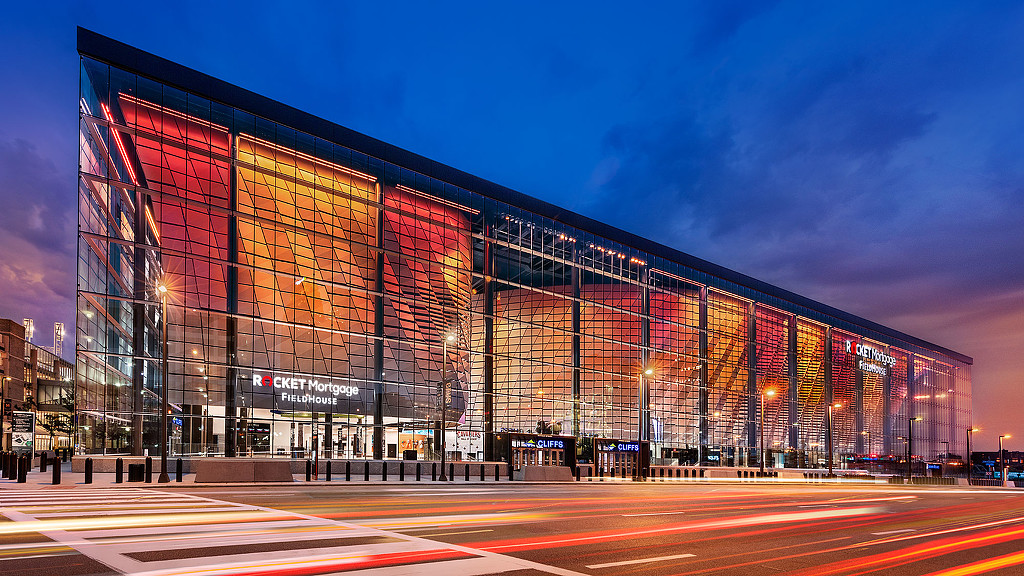Bringing Sports Back to the Venue
July 17, 2020 | By Ryan Sickman, Jonathan Emmett
Editor’s Note: This post is part of our ongoing exploration of how design is responding to the COVID-19 pandemic.
Sports leagues around the world have been shuttered for months, and we’re just now seeing some leagues restart games, albeit without audiences. As more teams and leagues start to think about reopening, we’ve been working with our clients to understand the challenges, questions, and potential strategies to get players and fans back to enjoying these experiences again — in person.
We’ve had extensive conversations with industry leaders and clients in every league to address today’s most pressing topics and questions. The questions they’ve been asking us include:
- “How can I optimize my ticket sales with social distancing in the seating bowl?”
- “What, if any, temporary team space modifications will be more permanent?”
- “What technology can I install now that won’t be a waste in the future?”
- “What will be the norm once there’s a vaccine?”
Based on these conversations, we’ve developed strategies for three incremental phases:
1. The immediate-term2. The return of fans to the venue
3. A reimagined future
Action plans for each phase
Here’s a look at strategies for each of the phases listed above.
Phase 1: The Immediate Term
This is a “players first” strategy focused on getting athletes and staff back into facilities safely. We’re in this phase now. Here are the priorities for this phase:
1. Cleanliness and sanitization is key.Cleanliness and sanitization is the number one thing we’re focused on, largely following CDC and other health guidelines, which may differ by jurisdiction. The immediate focus needs to be on protecting players’ and employees’ health and safety. People want to see overt actions taking place in venues that make them feel safe; they want to see health screenings, hand sanitizer stations, or the presence of cleaning staff. We’re considering how to bring some of these interventions, which are typically hidden behind the scenes, to the forefront.
2. Reexamine team spaces and operations.From locker rooms to the journey players take from the parking lot to team spaces, it’s important to consider how to protect the health and safety of players and staff at all touchpoints. That could include physically distancing or phasing usage in locker rooms, limiting entry points, introducing new sanitizing equipment, or establishing centralized check-ins for health and wellness screening and monitoring. Over the past several years, stadiums and arenas have introduced innovative ways to bring fans closer to the action. While things like players clubs may change in the interim, we need to look at new technologies and new ways of establishing connections to make fans feel closer to players once they return.
Phase 2: The Return of Fans to the Venue
This next phase looks at bringing fans back into stands while protecting their health and safety, looking at every aspect of the fan experience and understanding temporary changes to expect when doors open again. Here are 6 key strategies for making this phase a success:
1. Deliver a friction-free experience at the gate.One of biggest pressure points for sports venues takes place at the gates, before fans enter the venue, where they undergo security screenings, ticketing, and now, health screenings. A frictionless experience that prioritizes safety at entry points will help reassure fans once they’re inside the building. In addition to operational considerations, we’re looking at layouts for security lanes, such as where to introduce health and wellness screenings, limiting entry points, introducing timed entry by section, and other strategies for sequencing and queuing so people don’t have to wait hours to enter the building. We’re also looking at strategies for parking and tailgating.
2. Rethink food and beverage and concessions.Food and beverage concessions are among the high touchpoints for fans and guests inside the venue. Near-term solutions include temporary grab-n-go areas, mobile ordering and contactless payment, Plexiglas dividers to separate customers from employees, and personal protective equipment (PPE) for concession workers. It’s important to consider both the operational aspect of concessions and the physical environment to reduce friction in lines, queuing, and transactions.
3. Implement touchless technologies.Many touch-free technologies, such as touchless fixtures, mobile concessions ordering, or touchless/frictionless environments already exist, but until now, many venue operators haven’t had an impetus to implement them. As fans return to venues, we’ll learn lessons about what temporary technologies people want to use long-term, which will ultimately create a better experience for everyone.
4. Address health and safety concerns within restrooms.To address guests’ concerns about the health and safety of restrooms, consider implementing touchless fixtures and soap dispensers, one-way entry points, and increasing cleaning schedules and extra sanitizer stations. Staffing entries can help manage capacity and prevent crowding within confined spaces.
5. Introduce seating bowl interventions.We’re working with operators and ticketing and seating manufacturers to look at how to manage spacing in the seating bowl. One idea is General Admission (GA) seating — letting fans select where they want to sit. With technology that’s in place currently, we have the ability to work with teams and ticketing partners to control and dictate where people can sit relative to one another. This set up needs to be dynamic and is heavily reliant upon technology. Another idea is to remove seats to physically distance sections within the seating bowl; however, this poses an operational strain and limits the ability to upscale venues in a seamless fashion.
6. Signage and wayfinding are critical.Signage and wayfinding can have an immediate impact, helping to guide and educate staff, fans, and players throughout the venue. Consider implementing floor decals to adhere to physical distancing guidelines, entrance signage to follow CDC guidelines, direction signage for one-way and two-way concourses, and signage for health and wellness screening and monitoring.
Phase 3: A Reimagined Future
Finally, we’re considering how we can enhance sports venue design and ultimately improve the overall human experience of going to a sporting event. Consider the following 5 areas of focus for this phase:
1. Touchless entry experiences will become the norm.In the future, entry experiences will likely become touch-free, with digital ticketing, contactless payment, and touchless restrooms. Contactless transactions might eventually become permanent with expanded mobile ordering and in-seat service.
2. Integrate biometric technologies into sports venue design.Biometric technologies, including gesture activation, ocular-based technology interfaces, and facial recognition, are advancing. As these technologies improve, they will be more readily integrated into sports facility design. Visitors could potentially receive health or security screenings remotely, before they enter the venue.
3. Forgo static signage for dynamic, changeable digital signage.The venue of the future will likely move away from static signage in favor of fully changeable, activated, digital signage. Digital signage has caught up with science fiction prognostications like those in the movie “Minority Report,” and holographic effects, digital projection, and more capabilities are becoming readily available.
4. Revamp cleaning methods.To meet people’s heightened expectations for health and wellness, sports facilities will need to amp up cleaning and sanitation protocols to clean massive venues, such as arenas, swiftly and efficiently. That could include new sanitizing equipment; drones; sprayers; or UV lights, or self-sanitizing spaces; restroom; weight rooms; or training rooms.
5. Design a cohesive experience, from start to finish.Whether from arrival at the parking lot or entry gate, inside the building, or when fans exit the stadium or arena, experiences can’t be handled as individualized, singular interventions. As designers, we must create a cohesive experience that examines each touchpoint holistically, in concert with one another.
The reentry to sports will continue to evolve over the coming months. We trust that following a guide path from temporary to long-term, starting with a focus on safety, is the right path. Ultimately, our end goal is creating a better overall venue that enhances the human experience — for players, fans, employees, promoters, and anyone who participates and enjoys the action of live sporting events.
We believe every organization should have the tools needed during these uncertain times, and we want to help. Please contact us to begin a conversation about how our Sports practice can support you now and into the future.
For media inquiries, email .


